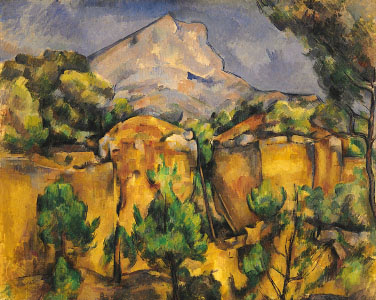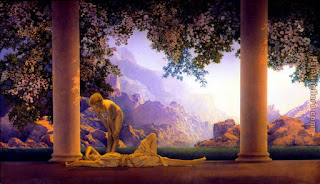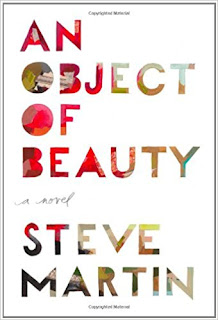 |
| "Cézanne et Moi." L- Guillaume Canet as Emile Zola, R-Guillaume Gallienne as Cézanne |
The French film, "Cézanne and I" or "Cézanne et Moi," is excellent, but will be of most interest to those who know the story of Cézanne's lifelong friendship with Émile Zola. Guillaume Gallienne, an actor of the Comédie Francaise gives an outstanding performance which zeroes in on his character as well as possible. As Émile Zola, Guillaume Canet is also very believable. The film direction and production tells the story extremely well, but also captures the colors and aesthetics well enough to make the viewer feel to almost be there.
 |
A studio that Cezanne kept within the
Bibemus Quarry |
Cézanne was the very first artist who really interested me--probably because of his colors. The most influential 20th century artist, Picasso, said he owed everything to Cézanne. Matisse claimed "he's kind of a god of painting." His popularity is similar to that of Van Gogh, who also was not appreciated in his lifetime. As for Émile Zola, many of the French claim him as their favorite novelist. So to think that these two giants of late 19th-century French culture were classmates and best of friends growing up is just amazing. It's also tribute to the school in Aix-en-Provence which nurtured two extraordinary geniuses.
Fortunately, the movie takes you through some of the beautiful scenery they roamed through in childhood, such as the trails around the Bibémus Quarry and Mont Saint-Victoire. There's a glimpse at the richness of color which he portrayed so well in his paintings, with that perfect balance of warm and cool colors. The movie didn't show the beautiful house he eventually inherited from his parents.
The film "Cézanne and I" explores Cézanne's character through the friendship and his relationship with others--wife, mother, father and others, and relates it to his art. Director Daniele Thompson picks up on the many mysteries of this relationship, the character of the artist and the personality of the man. Most of the film portrays Zola as less complicated and a little easier to understand as a person. Many people will want to see it to experience the landscape of Aix, which is beautiful. Criticism of the film comes from those who don't understand the dialogue, but again it helps to have some knowledge on the history of the friendship.
 |
| Mont Saint-Victoire from Bibémus Quarry at the Baltimore Museum of Art |
In high school, I was given the assignment to choose an artist to study and try to paint in his style. I chose Cézanne and it was difficult. In grad school, I was required to read Émile Zola's novels,
Nana and
The Masterpiece. (The class was on Manet and Degas.)
The Masterpiece is about an obsessive and frustrated artist who is also a bit of a failure. When it was published in the 1886, Cézanne interpreted it to be entirely about himself. The descriptions of their childhood wanderings together were true to life. I don't remember the book so well, but remember it reminding me more of Degas. Zola was a rip roaring success as a novelist by the time he wrote it, and very prolific.
The Masterpiece must have seemed like a slap in the face to Cezanne who was just as talented and worked as hard. Cézanne was 47 years old, but only knew rejection at that time. His recognition as an artist did not come until 10 years later -- when in his late 50s.
In reality, I had understood that Cézanne was so offended by the portrayal (parts of it are read in the film) that he would never speak to Zola again. In the movie, they are in contact again. From the film, I actually sympathize a great deal with both Cézanne and Zola. Zola claimed that Lantier, the artist in the novel, was a composite of artists he had known. It doesn't help that he describes their childhood friendship pretty much as it was. In Zola's novel, Lantier ends up killing himself, which certainly must have suggested to Cezanne the worthlessness of his artistic endeavors. However, the ending is consistent with Zola's style of naturalism which exposes the brutalities of life. As far as I know, none of the painters Zola knew actually took their own lives. In truth, Cezanne was never that satisfied with his own painting, even after he received some recognition.
 |
| Bibémus Quarry, near Aix-en-Provence, one of the many landmarks the artist painted |
The time period was great for artists and writers mutually supporting each other, hanging out the cafes together, a tradition that continued through the 1920s. Both Zola and Cézanne went to cafes and on social excursions with Manet and the Impressionists. However, Cézanne was frequently opinionated and offensive and, at the same time, more withdrawn than the others. After a few years, Cézanne retreated back to his native Provence while Zola stayed in Paris.
 |
| The trails near Bibemus Quarry |
The move flashes between childhood, early adulthood and various events in their lives. There is a third friend named Baptistin who became an engineer,
but also was a part of their threesome. Zola's father died when he was young and his mother struggled to support him. Cézanne had a difficult relationship with his banker father who wasn't supportive of his chosen profession. As an adult, he was consciously rebelling against his father whom he considered a social climber. As might be expected, Zola became the perfect bourgeois and played the part of worldly success quite well. Cézanne rejected many of the social graces, and was considered uncouth and boorish by some. Certainly many artists also fit the stereotype of being sloppy, such as the great Michelangelo and the great Masaccio whose nickname means "grubby Tom."
Cézanne was temperamental, as artists often are. It comes with the territory of obsessiveness. Hefrequently tore up his paintings. It's the frustration that is expressed well about Lantier, the artist in Zola's novel. Cézanne actually died of pneumonia in 1906 -- on a mountaintop while painting. He stuck to his goals until the very end, but was never satisfied with his painting. He was 67.
Cézanne got along well with Camille Pissarro, the oldest of the Impressionists and somewhat of a mentor for all artists in the group. They had a strong rapport and mutual respect. Cézanne and Édouard Manet (my other favorite artist from the period) did not like each other. This lack of compatibility is curious to me because some of their artistic goals (the way they see form and structure) appear somewhat similar. Each is important for redefining the structure of painting through innovative means of composition that rejected traditional foreground, middleground and background. Both artists were from well-to-do backgrounds, but the elegant Manet, is known to have thought of Cézanne as ill-mannered and coarse. Both artists received much public derision and criticism, but the younger artists of the avant-garde loved Manet.
 |
| A scene near Aix-en-Provence |
The movie even puts Cézanne next to the gorgeous Berthe Morisot, known for her refinement and close relationship to Manet. My personal impression is that Cézanne suffered from jealousy of Manet on many levels, especially since Manet was so admired by his fellow artists. His good friend Zola had written a well-known an important article in defense of Manet. Zola also defended Cézanne and the other artists who were Impressionists through his essays. However, the novel,
The Masterpiece expressed less respect for their style than one might expect.
 |
Cézanne, Mme Cézanne in Yellow Armchair
Art Institute of Chicago |
Cézanne's portraits of his wife have always amazed me for their detachment and lack of feeling. Was he at all in love with her. According to the movie, he loved her because she could sit hours without moving. Her rigid stillness was important to an artist who was trying to instill stability and geometry while using colors the way Impressionists did. None of his portraits of her show love or any feeling at all, and Thompson explores why. The filmmaker also suggests that Cezanne Zola's wife had at one time been involved -- before she married his friend. I'm not sure if that's the truth or just the filmmaker's conjecture.
Most of Cezanne's portraits are all about the structure and composition of the painting. Generally, they avoid feeling. The love and feeling we find in Cézanne is in his portrayal of nature particularly of portraits of the mountain he idolized, Mont Saint-Victoire.
There is feeling in the self-portraits -- the feeling of intensity and determination in his eyes. I think his self-portraits are excellent because they capture the strong shapes with contrasts of color. From these we can trace the formal properties that lead to the Cubist style of Picasso and Braque.
Quality films about artists help us to understand how an artist's mind works. This film helps us understand the artist more through his relationships rather than through the art itself. (I personally have a hard time teaching Cézanne.) The theme of denying his feelings and not showing that he cared for others comes up again and again. It's a selfishness that is in pursuit of art, and/or, ego. Yet, if had been only about ego, Cézanne would have given up years earlier.
He is an artist who died painting.
 |
| Self-portrait, Winterthur Collection, Switzerland |
In 2011, I went to his home in Aix-en-Provence, his studio and Bibemus Quarry where he did so many paintings. I will never forget the excellent tour guide at Bibemus Quarry, which thrilled Cézanne so much. The colors of those rocks really are the rich yellow ochres and reds that we see in Cézanne's paintings. The quarry had been used for buildings since Roman times, but the rocks had become too salty and sandy and it was abandoned in the1800s. You can really understand how the quarry's strong, virile presence inspired Cezanne. I realized that Mont Saint-Victoire and Bibémus Quarry are much further away from each other than in the impression from Cézanne's painting in Baltimore, shown above. Photographer Phil Haber's blog of Cezanne really
captures the beauty of his scenery today. However, Phil had to put together a composite of two photos to get the view in Baltimore. So we really do know that Cézanne's compositions broke up and rearranged the reality that he saw.
As for the writer's style, Zola is not closely akin to the Impressionists. Zola's writing is naturalism and he is important for describing things and the social classes with a gritty truth of lower class life. Impressionists were more inclined to overlook the brutal side of life. Renoir painted the working class of Montmartre, but idealized them--turning them into angels. Zola has more in common with Courbet and early Manet.




























